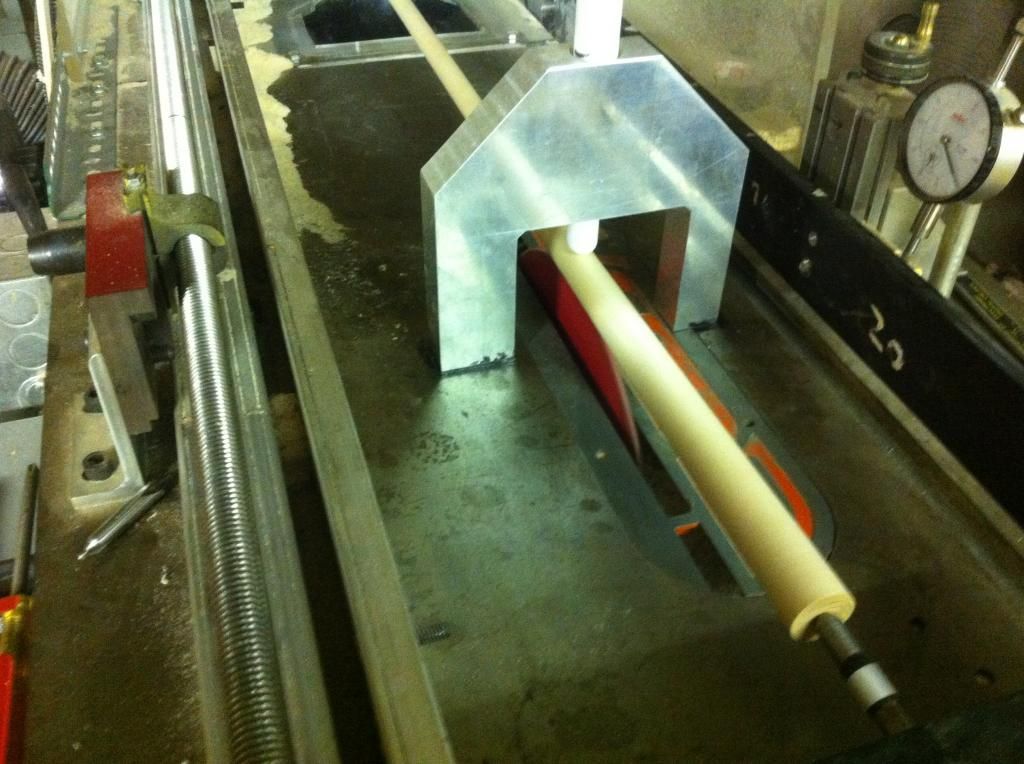I heard you take 15 minutes per pass ( .005" cut ) on your cnc taperer with Komo motor spindle and custom 20-flute bit.
I can't wait till someone tops that.
Next one probably massages the wood with air before taking a cut.
Joey,
I will try to top that but not sure.
80 Tooth Freud Triple Chip Flat Ground Carbide 10" saw blade at 6 minute travel gives me over 2 million touches of conventional cutting per shaft cycle.
DC controled motors.
Blades sharpened every 300 passes. 6 minute travel speeds and very sharp carbide blade reduces the shock factor to the wood.
Vernier controlled Adjustable spring loaded tail stock for repeatable tail stock pressure on shaft. The pressure must be so light that it is almost not enough to drive the tailstock live center. With the perfect pressure you are on the verge of rumming on the 60 center in the wood. A little spit on the center finds that goldielocks set point.
High end sealed bearings on both live and dead centers. $12.00 bearings on a press fit shaft have .003 run out. If you buy the good ones for $ 60.00 each, you get about .001 TRO.
Gravity feed follow rest with 19 gram Teflon bulleted business end and always cut a minimum .010 kerf. Except for the last spring pass @ 0. With out a rest there will be some frequency oscillation in the center or weakest area of the taper so the light .005 pass will give the shaft the opportunity to go into phugoid oscillation and it will bounce causing that area to become eccentric ( egg shaped ) and blur later between centers when viewed in a wood lathe at 1500 rpm . Without a rest, the last pass at .010 will give the blade more insertion into the kerf thus less opportunity to bounce in the middle. It will not eliminate the oscillation however. With the follow rest with the proper gram weighted bullet - Forgetaboutit! Set it and forget it!
I recently added my follow rest at the beginning of 2014 and if I had to give it up, I would quit cue making. Freaking Awesome!
I like Murray, don't get many warped shafts. If you buy good selected wood planks, process the wood correctly and use very repeatable machining controls, even wood that is less dense can spin like a laser between centers, every time!!!! Warped wood should be culled from the herd about one year after establishing the initial taper after cutting the second full taper cut or about .950 and letting it rest before seeing the bump. Then to the trash. Even hogging passes need to be slow also as not to shock the wood. I used to hog at 3 minute passes and the shock factor was rearing it's ugly head even with very sharp blades and I had no idea what was going on. The plane was flying me and I was not in control. Then I got religion and Joey Gold ( Master Yoda ) turned me on the the slow travel and explained the shocking factor to me concerning sharping cycles and saw blade rotation on my machines. After 300 passes I move the blade to my butt saw machine where it is less critical because of the dia. of the butts vs. oscillation and deflection factor.
If you make and use a follow rest as shown below. You will be happy. I guarantee it!:thumbup::happydance:
As to the OPs question, anyone who believes they can tell the difference between air or kiln dried hit is living in metaphysical world and is ruled by a collective thought, not reason. Since no two woods have the same fingerprint for tonality, how could you ever establish a baseline or be objective with a comparison especially when the hit is a subjective idea or notion. These things are organic for God's sake!
JMO,
Rick
Gravity Feed Teflon Bullet Follow Rest. This Gizmo is the most effective fixture in my shop and has the most profound end result. The effect it has on my shaft processing and final product can not be described in words. Well maybe "Nirvana" might do! LOL

